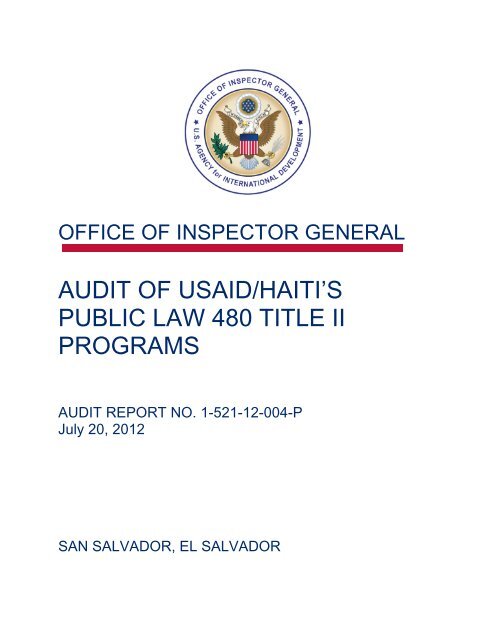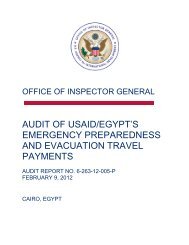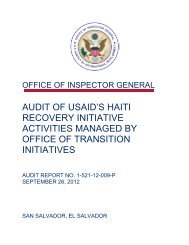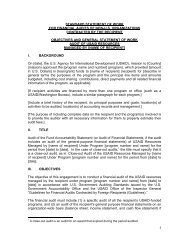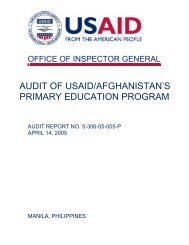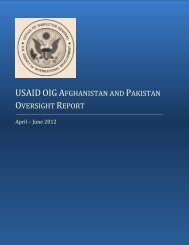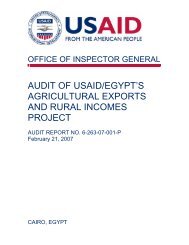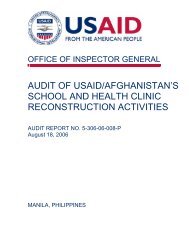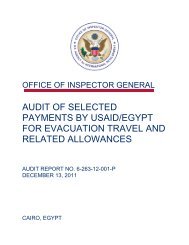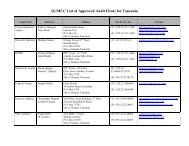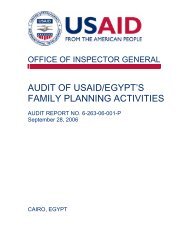Audit of USAID/Haiti's Public Law 480 Title II Programs
Audit of USAID/Haiti's Public Law 480 Title II Programs
Audit of USAID/Haiti's Public Law 480 Title II Programs
You also want an ePaper? Increase the reach of your titles
YUMPU automatically turns print PDFs into web optimized ePapers that Google loves.
OFFICE OF INSPECTOR GENERALAUDIT OF <strong>USAID</strong>/HAITI’SPUBLIC LAW <strong>480</strong> TITLE <strong>II</strong>PROGRAMSAUDIT REPORT NO. 1-521-12-004-PJuly 20, 2012SAN SALVADOR, EL SALVADOR
Office <strong>of</strong> Inspector GeneralJuly 20, 2012MEMORANDUMTO:FROM:SUBJECT:<strong>USAID</strong>/Haiti Mission Director, Carleene Dei<strong>USAID</strong>/Office <strong>of</strong> Food for Peace Director, Dina EspositoRegional Inspector General/San Salvador, Jon Chasson /s/<strong>Audit</strong> <strong>of</strong> <strong>USAID</strong>/Haiti’s <strong>Public</strong> <strong>Law</strong> <strong>480</strong> <strong>Title</strong> <strong>II</strong> <strong>Programs</strong>(Report No. 1-521-12-004-P)This memorandum transmits our final report on the subject audit. In finalizing the audit report,we considered your comments on the draft report and have included those comments in theirentirety in Appendix <strong>II</strong> <strong>of</strong> this report.The final report includes 10 recommendations to help the mission improve various aspects <strong>of</strong>the <strong>Public</strong> <strong>Law</strong> <strong>480</strong> <strong>Title</strong> <strong>II</strong> Program. Based on your written comments in response to the draftreport, management decisions have been reached on Recommendations 3 and 7. Pleaseprovide the <strong>Audit</strong> Performance and Compliance Division <strong>of</strong> <strong>USAID</strong>’s Office <strong>of</strong> the Chief FinancialOfficer with evidence <strong>of</strong> final action to close the open recommendations.A management decision was not reached on Recommendations 1, 2, 4, 5, 6, 8, 9, and 10.Please provide written notice within 30 days <strong>of</strong> any action planned or taken to implement theserecommendations.I want to express my appreciation for the cooperation and courtesies extended to us during thisaudit.U.S. Agency for International DevelopmentEmbajada AmericanaUrb. y Blvd Santa ElenaAntiguo Cuscatlan, Depto. La LibertadSan Salvador, El SalvadorTel.503-2501-2999 ·Fax(503-2228-5459www.usaid.gov
CONTENTS Summary <strong>of</strong> Results ................................................................................................................... 1 <strong>Audit</strong> Findings ............................................................................................................................. 4 Integration <strong>of</strong> Key Activities Was Uneven, Poorly Tracked, andTheir Impact Could Not Be Determined .................................................................................. 4Food for Peace and <strong>USAID</strong>/Haiti Did Not Identify BestPractices for Mothers’ Clubs ................................................................................................... 6 Recommended Approach for Preventing MalnutritionWas Not Implemented Fully .................................................................................................... 8Cooperating Sponsors Used Indicators That Were Excessive, Duplicative, and NotCoordinated Across the Program ............................................................................................ 9 Haiti’s <strong>Title</strong> <strong>II</strong> Program Overlapped With Other <strong>USAID</strong>-Funded <strong>Programs</strong> ........................... 11 Food for Peace Did Not Optimize Its Use <strong>of</strong> <strong>Title</strong> <strong>II</strong> Data Management Tools ...................... 13 Evaluation <strong>of</strong> Management Comments ................................................................................... 15 Appendix I—Scope and Methodology .................................................................................... 19 Appendix <strong>II</strong>—Management Comments ................................................................................... 22 AbbreviationsThe following abbreviations appear in this report:ADS Automated Directives SystemBCC behavior change communicationCRS Catholic Relief ServicesFANTA Food and Nutrition Technical AssistanceFFP Food for PeaceFY fiscal yearIFRP International Food Relief PartnershipITSH internal transport, shipping, and handlingLMMS Last Mile Mobile SolutionMCHN maternal and child health and nutritionMYAP multiyear assistance programP.L. <strong>Public</strong> <strong>Law</strong>PM2A Preventing Malnutrition in Children Under 2 ApproachRIG Regional Inspector GeneralTOPS technical and operational performance supportWINNER Watershed Initiative for National Natural Environmental Resources
SUMMARY OF RESULTS The Food for Peace Act (Agricultural Trade Development and Assistance Act <strong>of</strong> 1954), alsoknown as <strong>Public</strong> <strong>Law</strong> <strong>480</strong> (P.L. <strong>480</strong>) or Food for Peace (FFP) is the U.S. Government’s principalmechanism for implementing its international food assistance initiatives. The intent <strong>of</strong> thislegislation, which has been modified many times, to reduce hunger and malnutrition and assurethat people everywhere have enough food at all times for healthy, productive lives.Haiti’s P.L. <strong>480</strong> <strong>Title</strong> <strong>II</strong> 1 nonemergency program is directed by <strong>USAID</strong>’s Office <strong>of</strong> Food for Peacein Washington, D.C.; the daily activities are managed and monitored by the <strong>USAID</strong>/Haiti activitymanager. <strong>USAID</strong>/Haiti’s <strong>Title</strong> <strong>II</strong> multiyear assistance programs (MYAPs) focus on agriculturalproductivity, maternal and child health and nutrition (MCHN), natural resource management,education, safety net support, and early warning systems. The main goal <strong>of</strong> the program is toreduce food insecurity 2 and increase the resiliency <strong>of</strong> vulnerable and extremely vulnerable ruralhouseholds. MYAPs are awarded through cooperative agreements (versus contracts), andtherefore <strong>USAID</strong>’s control is limited to choosing the cooperating sponsors who respond with thebest overall proposals, which may or may not include the full range <strong>of</strong> possible interventions toassist beneficiaries.<strong>USAID</strong>/Haiti’s <strong>Title</strong> <strong>II</strong> programs operate through agreements <strong>USAID</strong> has with three cooperatingsponsors.Catholic Relief Services (CRS). Award from February 2008 to September 2012 for totalestimated program costs, including cost share, <strong>of</strong> $61.7 million.World Vision. Award from February 2008 to September 2012 for total estimated programcosts, including cost share, <strong>of</strong> $91.5 million.ACDI/VOCA. Award from February 2008 to February 2013 for total estimated programcosts, including cost share, <strong>of</strong> $37.4 million.As <strong>of</strong> January 2012, total program obligations and expenditures were $53,886,541 and$46,370,608, respectively. (The Scope and Methodology on page 19 for further explanation <strong>of</strong>program funding mechanisms).The objective <strong>of</strong> the audit was to determine whether the P.L. <strong>480</strong> <strong>Title</strong> <strong>II</strong> program in Haiti isreducing food insecurity and increasing the resiliency <strong>of</strong> vulnerable and extremely vulnerablerural households.1The P.L. <strong>480</strong> food aid program is comprised <strong>of</strong> three titles. Each title has different objectives andprovides agricultural assistance to countries at different levels <strong>of</strong> economic development. <strong>Title</strong>s <strong>II</strong> and <strong>II</strong>Iare administered by the Agency for International Development. <strong>Title</strong> <strong>II</strong> provides for the donation <strong>of</strong> U.S.agricultural commodities by the U.S. government to meet humanitarian food needs in foreign countries.2 According to the World Health Organization, “Food security is built on three pillars: food availability:sufficient quantities <strong>of</strong> food available on a consistent basis; food access: having sufficient resources toobtain appropriate foods for a nutritious diet; and food use: appropriate use based on knowledge <strong>of</strong>basic nutrition and care, as well as adequate water and sanitation.”(http://www.who.int/trade/glossary/story028/en/.)1
This audit determined that <strong>USAID</strong>/Haiti’s implementation <strong>of</strong> P.L. <strong>480</strong> <strong>Title</strong> <strong>II</strong> nonemergencyassistance generally has improved conditions for targeted beneficiaries and reportedly reducedthe number <strong>of</strong> underweight, stunted children younger than 5 years old. Site visits andbeneficiary interviews indicate that positive impacts include awareness and implementation <strong>of</strong>improved agricultural practices, increased crop yields, improved hygiene and sanitationpractices, access to credit via savings groups, and increased breast-feeding. However, wecould not determine whether the effects will last well into the future.The audit found that the mission was generally doing a good job managing the program. Forinstance, <strong>USAID</strong>/Haiti staff made frequent field visits to the cooperating sponsors’ activitylocations. <strong>USAID</strong>/Haiti staff and the cooperating sponsors also met frequently to discussproblems and share successful methodologies. The cooperating sponsors were flexible inlearning from one another, sharing and adopting each other’s best practices. Additionally, athorough, independent midterm evaluation <strong>of</strong> the program was conducted in fiscal year(FY) 2010.Since many program locations were extremely remote, the cooperating sponsors encounteredchallenges while implementing program activities. In addition, this particular program facedmore than the usual share <strong>of</strong> hardships, including severe flooding and four hurricanes inFY 2008, the devastating earthquake <strong>of</strong> January 2010, a cholera outbreak in October 2010, andupheaval around the time <strong>of</strong> the elections in 2009 and 2010.Although the program achieved many successes despite the challenging environment, the auditidentified the following areas for improvement:Integration <strong>of</strong> key activities was uneven and poorly tracked, and their impact could not bedetermined (page 4). FFP and <strong>USAID</strong>/Haiti did not identify best practices for mothers’ clubs (page 6). The recommended approach for preventing malnutrition was not implemented fully (page 8).Cooperating sponsors were using indicators that were excessive, duplicative, and notcoordinated across the program (page 9). Haiti’s <strong>Title</strong> <strong>II</strong> program overlapped with other <strong>USAID</strong>-funded programs (page 11).FFP did not optimize the use <strong>of</strong> <strong>Title</strong> <strong>II</strong> data management tools designed for the program(page 13).To help FFP and <strong>USAID</strong>/Haiti improve the efficiency and effectiveness <strong>of</strong> its P.L. <strong>480</strong> program,the Regional Inspector General (RIG)/San Salvador makes the following recommendations:1. Establish and implement a plan for the design, tracking, correlation, and analysis <strong>of</strong>maternal and child health and nutrition and livelihood integration for the fiscal year 2013multiyear assistance program (page 5).2. Establish and implement a plan for the design, tracking, correlation, and analysis <strong>of</strong> theeffectiveness and efficiency <strong>of</strong> mothers’ clubs for the fiscal year 2013 multiyear assistanceprogram (page 7).2
3. Develop and implement a plan to evaluate the cost-effectiveness and efficiency <strong>of</strong> thevarious mothers’ clubs that cooperating sponsors have implemented (page 8).4. Develop a cost estimate for implementing the first 1,000 days approach for the nextmultiyear assistance program to make sure potential cooperating sponsors incorporatesufficient resources in their budgets and demonstrate the capacity to implement themethodology fully (page 9).5. Include validation <strong>of</strong> implementation <strong>of</strong> the first 1,000 days approach in the monitoring planfor the next multiyear assistance program (page 9).6. Obtain expert food security technical assistance in developing the fiscal year 2013 multiyearassistance program performance indicator tracking tables to determine the most importantindicators to track, minimize inclusion <strong>of</strong> less significant ones, be sure that cooperatingsponsors use consistent terminology for similar indicators, and incorporate information thatis beneficial for research on food security assistance in the program indicators (page 11).7. Examine ongoing and proposed activities in Mirebalais to avoid duplicating efforts (page 13).8. Strengthen policies and procedures to confirm that programs that receive International FoodRelief Partnership grants are not duplicating <strong>Title</strong> <strong>II</strong> programs (page 13).9. Implement a plan to create a central repository for data management tools developed by<strong>Title</strong> <strong>II</strong> partners (page 15).10. Retain the ACDI/VOCA tool for potential inclusion in the repository for data managementtools (page 15).Detailed findings follow. The audit scope and methodology are described in Appendix I. Ourevaluation <strong>of</strong> FFP/Washington and <strong>USAID</strong>/Haiti’s management comments will appear on page15, and the mission’s comments will appear in Appendix ll.3
AUDIT FINDINGS Integration <strong>of</strong> Key ActivitiesWas Uneven, Poorly Tracked,and Impact Could Not Be DeterminedAutomated Directives System (ADS) 201.3.8 3 states that <strong>USAID</strong> missions should devise foreignassistance programs and activities to have the greatest possible development impact.Furthermore, this impact should be sustainable. <strong>USAID</strong> defines this concept in Strategy forSustainable Development as one that will permanently enhance the capacity <strong>of</strong> a society toimprove its quality <strong>of</strong> life.According to <strong>USAID</strong>’s 2009 <strong>Title</strong> <strong>II</strong> technical guidance, 4 the MCHN component should be linkedconsistently with the agricultural and livelihoods components <strong>of</strong> the program. Additionally,increased agricultural production and improved livelihoods activities may result in the food rationcomponent becoming less essential, because some families are better able to support and feedtheir families.The program’s 2010 midterm evaluation noted the lack <strong>of</strong> integration between the livelihood andMCHN components, and it recommended linking the two in the future. CRS and ACDI/VOCAboth made efforts to address the recommendation. CRS increased integration <strong>of</strong> home gardensand savings groups in its mothers’ clubs, which were small groups <strong>of</strong> beneficiary mothers (ormothers <strong>of</strong> beneficiary children) gathered to discuss program materials. ACDI/VOCA amendedits program approach to increase integration with the MCHN component when possible andbegan integrating home gardens and promoting alternative nonagricultural livelihoodopportunities.However, despite the technical guidance and the evaluation’s recommendation, <strong>USAID</strong>/Haiti’sintegration <strong>of</strong> the livelihood and MCHN components was inconsistent, and the tracking <strong>of</strong> thelinks was weak to nonexistent.ACDI/VOCA was limited in its integration approach because it <strong>of</strong>fers the two components inonly 5 <strong>of</strong> 10 communes in the target area (Haiti’s Ministry <strong>of</strong> Agriculture discouraged fooddistribution in the agroecologically favored areas in ACDI/VOCA’s region). Even whenACDI/VOCA <strong>of</strong>fered both in a target commune, they were not always integrated.World Vision also amended its program description after the evaluation, stating, “A majoreffort will be made to continue linking agriculture production and livelihood enhancementactivities with MCHN activities.” However, the auditors did not find evidence to supportimplementation <strong>of</strong> this strategy during field visits, and World Vision explained it is only<strong>of</strong>fering integrated MCHN and livelihood components in 8 <strong>of</strong> the 16 communes because <strong>of</strong>resource limitations.3ADS 201.3.8 was revised on January 17, 2012. The citations in this report refer to the previous version<strong>of</strong> ADS, in effect during the period covered by the audit.4TRM-01: Preventing Malnutrition in Children Under 2 Approach (PM2A): A Food-Assisted Approach.Produced by the Academy for Educational Development for <strong>USAID</strong>, Washington, D.C., October 2009.4
In addition to the varying levels <strong>of</strong> integration among the three cooperating sponsors, none hadoriginally developed indicators to measure the level <strong>of</strong> integration <strong>of</strong> the two components (e.g.,how many beneficiaries are receiving both types <strong>of</strong> assistance).After the midterm evaluation, CRS started tracking this information in 2011; however, it trackedintegration <strong>of</strong> livelihoods with mothers’ clubs rather than with MCHN beneficiaries, and only half<strong>of</strong> the MCHN beneficiaries were in the clubs in FY 2011. In addition, the definition for thisindicator does not succinctly define livelihoods assistance. CRS <strong>of</strong>ficials said it was bringing ina consultant to improve how it gathers and reports data.ACDI/VOCA started tracking MCHN and livelihoods integration in 2011. However, the data areinternal and not part <strong>of</strong> its performance reporting to <strong>USAID</strong>. In addition, ACDI/VOCA <strong>of</strong>ficialssaid the data are not very accurate because the information comes from beneficiaries who arereluctant to report that they benefit from both programs because they fear <strong>of</strong> losing services oreligibility. World Vision has not developed an indicator for or tracked MCHN beneficiariesreceiving livelihood assistance.Since the 2008 <strong>Title</strong> <strong>II</strong> guidance the cooperating sponsors used in designing their programs didnot specify integrating MCHN and livelihoods activities, cooperating sponsors did not developindicators to track integration. The guidance provided in 2009 encouraging integration was notadopted fully into the program.Without accurate tracking, <strong>USAID</strong> cannot determine whether integrating the two componentshas had a better, more sustainable impact for beneficiaries than just the MCHN interventions doon their own. <strong>USAID</strong>/Haiti cannot determine the value these activities provide. FFP hascontracted two separate entities, FANTA 5 (now FANTA-2) and TOPS (technical and operationalperformance support), 6 to analyze <strong>Title</strong> <strong>II</strong> data. According to FANTA-2 <strong>of</strong>ficials, these data havebeen weak or lacking historically, and they are needed throughout <strong>Title</strong> <strong>II</strong> programs. Having thisinformation would help <strong>USAID</strong> make informed decisions about any future adjustments to theprogram.The 2012 Country Specific Information for Haiti contains guidance for integrating livelihoodactivities with MCHN households for the next MYAP. This requirement was added to promotemore women-focused livelihood integration, although the decision was not based on anyevidence that this approach has provided a more positive impact. <strong>USAID</strong>/Haiti <strong>of</strong>ficials saidthere was no practical way to measure the impact <strong>of</strong> integration efforts <strong>of</strong> the current MYAP.However, the next P.L. <strong>480</strong> program could help assess whether interventions <strong>of</strong> livelihoodactivities can have a significant and potentially sustainable impact on reducing food insecurityfor MCHN beneficiaries. Based on this we make the following recommendation.Recommendation 1. We recommend that Food for Peace and <strong>USAID</strong>/Haiti establishand implement a plan for the design, tracking, correlation, and analysis <strong>of</strong> maternal andchild health and nutrition and livelihood integration for the fiscal year 2013 multiyearassistance program5The Food and Nutrition Technical Assistance <strong>II</strong> Project (FANTA-2) provides technical support to <strong>USAID</strong>and its partners to improve nutrition and food security policies, strategies, and programs.6FFP’s contract “Technical and Operational Performance Support - Program for FFP Grantees,” orTOPS, is designed to capture best practices for improved methodologies in <strong>Title</strong> <strong>II</strong> food aid commodityprograms.5
Food for Peace and <strong>USAID</strong>/HaitiDid Not Identify Best Practicesfor Mothers’ ClubsAccording to ADS 200.3.2.2, <strong>USAID</strong> seeks to identify its customers and to secure theirparticipation in order to better target projects and to focus the Agency’s efforts and resources onthe most productive tasks. In addition, ADS 201.3.8 7 states that <strong>USAID</strong> missions should deviseforeign assistance programs and activities to have the greatest possible impact ondevelopment.Behavior change communication (BCC) is an approach that <strong>Title</strong> <strong>II</strong> cooperating sponsors use toreduce malnutrition and disease. Mothers’ clubs are one <strong>of</strong> the primary vehicles thethree cooperating sponsors use to convey BCC to <strong>Title</strong> <strong>II</strong> beneficiaries, and this is done throughtraining on breast-feeding, child feeding practices, treatment <strong>of</strong> diarrhea, nutrition, immunization,family planning, and hygiene. BCC can have a critical impact on the survival <strong>of</strong> young children;for instance, ADS 212 states that among all preventive health and nutrition interventions,improved breast-feeding has the greatest potential to reduce mortality for children younger than5—by up to 13 percent. 8The audit found evidence that BCC is succeeding in Haiti. However, while the cooperatingsponsors are using similar information and presentation, they are not all using the samemothers’ club models for disseminating information. According to a TOPS representative, themost efficient, effective model is the “care group” model. This model uses a paid staff healthpromoter to train and support groups <strong>of</strong> mothers twice per month, with each group made up <strong>of</strong>10 to 15 volunteers selected by the community. These women, called “leader mothers,” arethen responsible for teaching what they have learned to ten households. The multiplier effect <strong>of</strong>this method is that 100 to 150 women are trained for every staff health promoter.The audit found that only one <strong>of</strong> the cooperating sponsors, ACDI/VOCA, was using the caregroup model. ACDI/VOCA started out with the traditional mothers’ club but switched to the caregroup model in 2010 in response to the midterm evaluation’s recommendation that the modelshould be considered. World Vision and CRS were using traditional mothers’ clubs. WorldVision organizes its clubs based on age (clubs <strong>of</strong> women whose children are younger than 2) orphysiological status (pregnant or lactating women, mothers <strong>of</strong> malnourished children). CRSwas working to duplicate this model.CRS’s model limits the membership <strong>of</strong> the mothers’ clubs to mothers selected by the communityvolunteers. During site visits, the audit team interviewed several mothers who wanted to be in aclub but had not been selected. The midterm evaluation’s team had similar observations; whenthey asked a group <strong>of</strong> women why they were not in a club, the response was “We have notbeen invited to do so,” or “We have not been authorized to do so.” The women noted thatmothers in the clubs had a great advantage because <strong>of</strong> what they learned about caring for theirchildren. The evaluation further stated that the community volunteers need to be involved, butas trainers under the care group model.7ADS 200.3.2.2 and 201.3.8 were revised on January 17, 2012. The citations in this report refer to theprevious version <strong>of</strong> ADS in effect during the period covered by the audit.”8G. Jones et al., “How many child deaths can we prevent this year?” Lancet, July 5, 2003, 65-71.6
The audit also supports the results <strong>of</strong> a study referenced by TOPS showing that the care groupmodel is the more cost-effective method for reaching wide audiences. For instance, while WorldVision succeeded in reaching more than 90 percent <strong>of</strong> its target population with BCC, it was lessefficient than ACDI/VOCA. Only 9 mothers on average were trained in mothers’ clubs versus100 trained in ACDI/VOCAs’ mother care groups. In addition, World Vision’s clubs had a ratio<strong>of</strong> 50 percent paid personnel supporting its clubs compared with ACDI/VOCA’s ratio <strong>of</strong>10 percent (as in the chart below). By using the traditional mothers’ clubs (using fewerresources than World Vision), CRS reached at least 600 more mothers than ACDI/VOCA did.However, CRS started out with almost half <strong>of</strong> its mothers’ clubs carried over from its previous<strong>Title</strong> <strong>II</strong> program, and ACDI/VOCA didn’t start using the care group model until FY 2011.Mothers’ Clubs Summary (Unaudited)Element World Vision ACDI/VOCA CRSNumber <strong>of</strong> mothers’ clubs 1,950 38 253Number <strong>of</strong> mothers receiving BCCmessages17,500 3,800 4,405Mothers trained per club 9 100 17Percent <strong>of</strong> coverage in targetlocationGreater than 90 34 Not trackedNumber <strong>of</strong> paid people assistingclubs299 40 16Number <strong>of</strong> unpaid volunteersassisting clubs300 380 190Total people assisting clubs 599 420 206Percent volunteers 50 90 92Percent paid personnel 50 10 8Sources: World Vision, ACDI/VOCA, and CRS.Thus, World Vision reached a large number <strong>of</strong> beneficiaries, but was not as cost-effective asACDI/VOCA. While CRS was more cost-effective, it reached fewer mothers than would havebeen possible had it used the care group model (and potentially reduced the incidence <strong>of</strong> childmortality and stunting by a greater percentage). The data suggest that incorporation <strong>of</strong> thismethodology could have increased the BCC received by program beneficiaries at less cost if allthe sponsors had adopted the care group model when MYAP began.The cooperating sponsors used mothers’ clubs as the main vehicle for disseminating BCC tobeneficiaries. The next MYAP also requires effective use <strong>of</strong> BCC interventions for improvingnutrition, hygiene, and health practices, however, leaving implementation methodology to thepotential awardees to propose. Although <strong>USAID</strong>/Haiti <strong>of</strong>ficials say the care group model isgood, they do not want to recommend one model over another without further validation;however, there is no way to validate the model during this MYAP because that is not part <strong>of</strong>FFP’s programing. The MYAPs are awarded through cooperative agreements that permitcooperating sponsors to adopt their own activity models. FFP will participate in validatingactivity models only if a cooperating sponsor suggests it. Therefore, the <strong>Title</strong> <strong>II</strong> program is notgeared to make sure that the greatest possible development impact is achieved.To improve the implementation <strong>of</strong> <strong>Title</strong> <strong>II</strong> activities related to mothers’ clubs, we make thefollowing recommendations.7
Recommendation 2. We recommend that Food for Peace and <strong>USAID</strong>/Haiti establishand implement a plan for the design, tracking, correlation with impact, and analysis <strong>of</strong>the effectiveness and efficiency <strong>of</strong> mothers’ clubs for the fiscal year 2013 multiyearassistance program.Recommendation 3. We recommend that Food for Peace develop and implement aplan to evaluate the cost-effectiveness and efficiency <strong>of</strong> the various mothers’ clubmodels being implemented by <strong>Title</strong> <strong>II</strong> cooperating sponsors.Recommended Approach forPrevention <strong>of</strong> MalnutritionWas Not Implemented Fully<strong>USAID</strong>’s best practice for preventing malnutrition is the “Preventing Malnutrition in ChildrenUnder 2 Approach” (PM2A). PM2A is a food-assisted approach that targets a package <strong>of</strong> healthand nutrition interventions to all pregnant women, mothers <strong>of</strong> children younger than 23 monthsold, and children younger than 2 in food-insecure program areas. Because they are the mostnutritionally-vulnerable members <strong>of</strong> the population, the program targets everyone in thesegroups to protect children from malnutrition and its long-term consequences. 9 PM2A differsfrom the traditional recuperative approach, which targets children younger than 5 once theyhave become malnourished. 9<strong>USAID</strong>’s support for PM2A is based on a 2002-2006 study <strong>of</strong> a <strong>Title</strong> <strong>II</strong> program in Haiti thatfound the preventive approach was more effective in reducing the prevalence <strong>of</strong> stunted,underweight children and overall malnutrition than the recuperative approach. 10 In addition, thestudy showed that PM2A was cost-effective because it had lower direct program costs perbeneficiary month 11 than the recuperative approach ($15 versus $21).Although all three cooperating sponsors’ cooperative agreements stated that they wouldimplement the fundamentals <strong>of</strong> PM2A, World Vision was the only one to do so from the start.The other two sponsors embraced the approach later.ACDI/VOCA did not incorporate PM2A into its activities initially; instead, it awarded thehealth component to a partner, Management Sciences for Health, which did not use PM2A.ACDI/VOCA found that the partnership was not working and subsequently terminated theagreement. ACDI/VOCA then clarified and submitted the new health strategy to <strong>USAID</strong> andin FY 2010 began full-scale implementation <strong>of</strong> PM2A.CRS chose to pilot PM2A model slowly because <strong>of</strong> (1) resource constraints, (2) lack <strong>of</strong>storage capacity and staff at the commodity distribution centers, and (3) a desire toimplement gradually to be sure the model was working.9Preventing Malnutrition in Children Under 2 Approach (PM2A): A Food-Assisted Approach.10 Purnima Menon and Marie T. Ruel, Prevention Is Better than Cure, Final Report <strong>of</strong> the Evaluation:Prevention or Cure? Comparing Preventive and Recuperative Approaches to Targeting Maternal andChild Health and Nutrition <strong>Programs</strong> in Rural Haiti. Academy <strong>of</strong> Educational Development,Washington, DC, July 31, 2007.11Beneficiary month means that each child or pregnant or lactating woman is counted once for eachmonth he or she is in the program.8
The partial implementation occurred because <strong>USAID</strong> did not embrace PM2A from the start ormake sure it was implemented fully, although all three cooperating sponsors had included it intheir proposals and the 2009 technical guidance promoted it.CRS reported the pilot approach for implementing PM2A in its 2009 “Pipeline and ResourceEstimate Proposal,” 12 but did not specify in this document—or any subsequent reporting—whereand to what extent it was implementing PM2A. The <strong>Title</strong> <strong>II</strong> activity manager in Haiti thought thatCRS had implemented PM2A at least to some degree in most <strong>of</strong> the target areas. However, as<strong>of</strong> December 2011, CRS had implemented the program in just half <strong>of</strong> them. In addition, asmentioned above, CRS lacked sufficient resources for implementing PM2A and continues toimplement it only partially. Had the method been fully embraced and rapidly implemented byboth ACDI/VOCA and CRS, malnutrition would likely have further decreased in their targetlocations.FFP’s announcement for the next <strong>Title</strong> <strong>II</strong> program in Haiti states that development partnersshould use PM2A, which is renamed the “first 1,000 days approach.” 13 To ensure that the nextMYAP fully implements this approach, we make the following recommendations.Recommendation 4. We recommend that Food for Peace and <strong>USAID</strong>/Haiti develop acost estimate for implementing the first 1,000 days approach for the next multiyearassistance program to make sure potential cooperating sponsors incorporate sufficientresources in their budgets that demonstrate the capacity to fully implement theapproach.Recommendation 5. We recommend that <strong>USAID</strong>/Haiti include validation <strong>of</strong>implementation <strong>of</strong> the first 1,000 days approach in the monitoring plan for the nextmultiyear assistance program.Cooperating Partners Used IndicatorsThat Were Excessive, Duplicative, andNot Coordinated Across the ProgramAccording to ADS 200.6, performance indicators are used to observe progress and measureactual results compared with expected results. Performance indicators help answer how orwhether a <strong>USAID</strong> mission/<strong>of</strong>fice is progressing toward its objective. ADS 203.3.4.2 states that,among other things, good performance indicators should be:Objective, or unambiguous about what is being measured and precisely defined in theperformance management plan.Useful for management at the relevant level <strong>of</strong> decision making.Adequate or including only as many indicators as are necessary and cost-effective forresults management and reporting purposes.12 The pipeline and resource estimate proposal describes an awardee’s food aid resource needs andactivities for a food aid program over the course <strong>of</strong> the upcoming implementation year.13The country specific information for Haiti for fiscal year 2012 notes that the first 1,000 days approachwas previously referred to as “Preventing Malnutrition in Children Under Two Approach” (PM2A).9
Additionally, ADS 203.3.3.2 states that only information that is directly useful for performancemanagement should be collected and reported. More information is not necessarily betterbecause it markedly increases the management burden and cost to collect and analyze.The cooperating sponsors’ indicators did not comply fully with ADS standards. Although ADSstates that a minimum number <strong>of</strong> indicators should be chosen, World Vision is tracking73 indicators, CRS is tracking 63, and ACDI/VOCA is tracking 47. Mission <strong>of</strong>ficials andcooperating sponsors agreed that they were tracking too many indicators, for which all threesponsors said there is a large monitoring and reporting burden. In addition, some indicatorswere duplicative or irrelevant.The 2010 evaluation recommended reducing the number <strong>of</strong> output indicators that eachcooperating sponsor was required to tracked and increasing the number <strong>of</strong> outcome and impactindicators. The evaluation further stated that FFP and <strong>USAID</strong> require indicators that are similar,but different enough to require separate tracking and reporting, and that tracking all the datarequired is very costly. The evaluation suggested other indicators that were not being trackedbut should be. FANTA-2 also reported that the cooperating sponsors were not always trackinginformation that would help evaluate the <strong>Title</strong> <strong>II</strong> program. For instance, tracking thebeneficiaries who receive both MCHN and livelihood benefits could help FANTA-2 assess theimpact <strong>of</strong> integrating these activities.In addition, it is difficult to evaluate the overall program progress and results because theindicators vary among the cooperating sponsors. While there are differences in the sponsors’approaches, there are also many similarities that would lend themselves to more standardizedreporting. For instance, all three have a custom indicator to report the number <strong>of</strong> beneficiariesreceiving food rations, an important data point for several programmatic reasons. However,these cannot be summarized because each indicator defines beneficiaries differently: WorldVision includes four types <strong>of</strong> beneficiaries, CRS counts women receiving health services, andACDI/VOCA counts the number <strong>of</strong> pregnant and lactating mothers receiving food rations. 14World Vision. World Vision did not address the duplicative indicators mentioned in theevaluation, and they remain in the indicator tracking tables. In addition, World Vision added 16new indicators in 2011 (none <strong>of</strong> which were recommended by the evaluation team), continues toinclude indicators in its annual report for which no achievements have been reported, andremoved 3 from the tracking tables without explanation to <strong>USAID</strong>.CRS. CRS also did not address the duplicative indicators mentioned in the evaluation, and theyremain in the tracking tables. CRS has yet to report on “number <strong>of</strong> people with increasedeconomic benefits derived from sustainable natural resource management and conservation asa result <strong>of</strong> USG assistance,” which CRS <strong>of</strong>ficials said was never formalized and put into themonitoring and evaluation system. The mission never agreed on a methodology formeasurement, and therefore the indicator was not included in the baseline. CRS agreed thatthe information for the indicator would be collected for the final evaluation.ACDI/VOCA. ACDI/VOCA was the only cooperating sponsor that addressed the evaluation’sindicator comments directly. Of the three cooperating sponsors, it is reporting on the fewest14An additional example is the indicator for the number <strong>of</strong> savings groups, which each sponsor definesdifferently. ACDI/VOCA is measuring “number established”; CRS, “number assisted”; and WorldVision, “number trained and monitored.”10
indicators: 47. In its written comments on the evaluation, ACDI/VOCA agreed that there weretoo many indicators. In the MYAP amendment, ACDI/VOCA proposed dropping seven andadding three that were similar to the indicators recommended by the evaluation.The reason so many indicators are included in the MYAPs is that <strong>USAID</strong> requires <strong>Title</strong> <strong>II</strong>cooperating sponsors to report on the mission’s indicators and FFP’s indicators. In addition, thesponsors develop their own indicators for program management purposes. Mission staffmembers said their hands are tied to a certain extent because there are many stakeholders allrequiring their own specific information.The FFP indicator guidance is issued piecemeal in three separate bulletins. The latest guidanceupdates only impact indicators; the FFP staff is waiting for on the revision <strong>of</strong> the mission’sindicators before updating annual monitoring indicators.Because each cooperating sponsor has its unique approach for implementing the program,<strong>USAID</strong> believes that it is only natural that indicators will vary among the sponsors. However,the evaluation stated that all three <strong>of</strong> the Haitian MYAPs have almost the same set <strong>of</strong> indicatorsin common, but they are sometimes worded differently in each organization’s indicatorperformance tracking tables. Even though <strong>USAID</strong> and the cooperating sponsors met at the start<strong>of</strong> the MYAP to discuss the indicators, they were not successful in creating one set for all. Had<strong>USAID</strong> provided guidance in the solicitation to use a set <strong>of</strong> common indicators—with the samewording in all three MYAPs—it could have made better comparisons. Like the evaluation’steam, we had difficulty reconciling and comparing data in the indicator performance trackingtables.In addition, the evaluation stated, “Data are being tracked to meet the quarterly needs <strong>of</strong> theindicator performance tracking tables, without sufficient analysis <strong>of</strong> data gathered at regionalsites on outcomes and impacts at the local level on the most vulnerable—which is what the FFPprogram is all about.” The sponsors are collecting and tracking additional data but not reportingthem in the indicator performance tracking tables because <strong>of</strong> the already substantial reportingburden. In some cases, the data were more useful than the data reported in the tracking tables.Without this type <strong>of</strong> information, <strong>USAID</strong> and the larger FFP program do not know the true impact<strong>of</strong> the MYAPs. Staff from both FANTA-2 and TOPS told the audit team that there is insufficientdata to evaluate certain components. Unless the most critical information is captured andreported by the cooperating sponsors in the formal reporting channels, the data will notcontribute to the better understanding or improvement <strong>of</strong> <strong>Title</strong> <strong>II</strong> programs.Therefore we make the following recommendation.Recommendation 6. We recommend that Food for Peace and <strong>USAID</strong>/Haiti obtainexpert food security technical assistance in the development <strong>of</strong> the fiscal year 2013multiyear assistance program indicator performance tracking tables to (1) determine themost important indicators to track, (2) minimize inclusion <strong>of</strong> less significant indicators,(3) provide consistent terminology for similar indicators used by cooperating sponsors,and (4) fully incorporate information beneficial for research on food security assistance inthe program indicators.Haiti <strong>Title</strong> <strong>II</strong> Program Overlapped WithOther <strong>USAID</strong>-Funded <strong>Programs</strong>11
The careful coordination <strong>of</strong> foreign assistance is imperative if U.S. taxpayer funds are to bespent effectively and efficiently. To this end, ADS 200.3.5.2 states that missions should seek touse other development organizations’ resources and nonassistance tools to magnify results anddeploy resources strategically, while avoiding duplicating efforts.The audit found evidence <strong>of</strong> duplicating efforts with other <strong>USAID</strong>-funded programs in two <strong>Title</strong> <strong>II</strong>regions in Haiti.World Vision and Watershed Initiative for National Natural Environmental Resources(WINNER). During field visits to World Vision sites in Mirebalais, where World Vision has beenoperating since 2008, several beneficiaries reported receiving assistance from the <strong>Title</strong> <strong>II</strong> and<strong>USAID</strong>’s Watershed Initiative for National Natural Environmental Resources (WINNER)programs. The purpose <strong>of</strong> WINNER, which began in June 2009, is to increase agriculturalproductivity, improve watershed stability, and strengthen agricultural markets. To this end,WINNER assists mango farmers in Mirebalais. World Vision supports mango production in thesame area and with the same beneficiaries.In November and December 2011, the audit team discussed the overlap with World Vision andthe mission. In response, <strong>USAID</strong>/Haiti <strong>Title</strong> <strong>II</strong> staff members said they previously informed themission staff overseeing WINNER about the potential overlap and were told that WINNERwould be pulling out <strong>of</strong> the area and therefore any possible overlap would only occur for a shorttime. However, <strong>USAID</strong> subsequently decided to continue WINNER activities in Mirebalais.At the end <strong>of</strong> February 2012, because the audit team called attention to this problem, <strong>of</strong>ficialsfrom World Vision, WINNER, and the mission met to discuss activities in Mirebalais. WINNERand World Vision <strong>of</strong>ficials assured the mission that there wasn’t duplication because WorldVision addresses commercial activities and WINNER addresses production. Nevertheless,mission <strong>of</strong>ficials acknowledged that they needed to examine both implementers more closely,and they intended to follow up on the problem, particularly since a third implementer will beworking in Mirebalais under the FFP initiative.ACDI/VOCA and Batey Relief Alliance. ACDI/VOCA informed the audit team that efforts wereduplicated in its region with the Batey Relief Alliance program. Batey operates in the DominicanRepublic and is funded by the FFP <strong>of</strong>fice in Washington through the International Food ReliefPartnership (IFRP). Batey’s area <strong>of</strong> operation extends to villages along Haiti’s southeasternborder. Like ACDI/VOCA, Batey operates to reduce food insecurity and malnutrition, and it isdistributing food within the same communes and to the same target population as ACDI/VOCA.In an October 2010 letter, Batey notified ACDI/VOCA that it would begin operating inACDI/VOCA’s region and asked whether ACDI/VOCA would be interested in collaborating. Inearly 2011 ACDI/VOCA informed the mission <strong>of</strong> the potential duplication <strong>of</strong> effort, and accordingto ACDI/VOCA, the mission subsequently confirmed the program overlap. In December 2011the audit team also raised the problem with the mission. Officials there acknowledged theduplication and said they had communicated this to Washington but never received a response.In February 2012 <strong>USAID</strong>/Haiti staff communicated directly with the Batey manager, who agreedto stop distributing food by the end <strong>of</strong> the month and not resume pending further discussion with<strong>USAID</strong> and ACDI/VOCA. According to <strong>USAID</strong>/Haiti, this discussion was planned for April 2012.The main reason Batey overlapped with <strong>Title</strong> <strong>II</strong> is that IFRP largely relies on grant applicants tobe aware <strong>of</strong> other donors in a country or region to avoid potential overlap issues. However,12
IFRP staff members said <strong>Title</strong> <strong>II</strong> applicants and/or their local partners might not be aware <strong>of</strong> theirproposed activities overlapping with other implementer activities carried out for other <strong>USAID</strong>programs. The wording <strong>of</strong> the criterion in the IFRP grant applications (“awareness <strong>of</strong> otherdonor activity in the same district/region/country”) could be interpreted in several different waysand may need to be clarified.The missions also review IFRP grant applications, but in this instance, <strong>USAID</strong>/Haiti did notidentify the potential overlap as a problem. IFRP staff said that at the time the mission wasdealing with the aftermath <strong>of</strong> the January 2010 earthquake and focused on urgent relief efforts.The overlap between WINNER and <strong>Title</strong> <strong>II</strong> occurred because <strong>of</strong> a lack <strong>of</strong> communication. WorldVision <strong>of</strong>ficials said they did not meet regularly with WINNER staff. The FFP <strong>of</strong>ficer said thatalthough interaction between the two implementers’ staffs takes place in the field, theinformation is not communicated to headquarters in Port-au-Prince. Because the audit teamcalled attention to these problems, the mission asked to meet with WINNER and World Vision.Duplicating efforts results in some beneficiaries receiving similar benefits and reducing the pool<strong>of</strong> resources to provide to potential beneficiaries. In Mirebalais, there is not sufficient evidencethat these services are complementary rather than duplicative. In ACDI/VOCA’s region, theBatey program is occurring in the same communes as <strong>Title</strong> <strong>II</strong> food distribution efforts. Theneeds in the region are great, and there is a range <strong>of</strong> other activities that Batey could beundertaking instead. Therefore we make the following recommendations.Recommendation 7. We recommend that <strong>USAID</strong>/Haiti examine ongoing and proposedactivities in Mirebalais to avoid duplication <strong>of</strong> effort.Recommendation 8. We recommend that Food for Peace Washington strengthen itspolicies and procedures to make sure International Food Relief Partnership grantees’programs are not duplicating <strong>Title</strong> <strong>II</strong> programs.Food for Peace Did Not Optimize ItsUse <strong>of</strong> <strong>Title</strong> <strong>II</strong> Data Management ToolsEfficiency and effectiveness must be optimized in order for <strong>USAID</strong> to maximize the impact <strong>of</strong>scarce development resources. OMB Circular A-11 2006, Section 26, Part 26.1, states thatbecoming more effective and efficient will help the government make better use <strong>of</strong> taxpayers’dollars and in some cases also operate with fewer resources.According to ADS 318.3.1.5, assistance awards to U.S. small businesses and nonpr<strong>of</strong>its shouldinclude a provision that allows the recipient to take title to inventions, subject to certain rightsand restrictions, including providing the government with a nonexclusive, nontransferable,irrevocable, paid-up license to use or authorize others to use the invention throughout the world.<strong>Title</strong> <strong>II</strong> programs entail a large amount <strong>of</strong> data collection. For instance, in FY 2011 World Visionreported providing food rations to 166,734 beneficiaries in Haiti. In addition, <strong>Title</strong> <strong>II</strong> data havebecome more complex as the program evolved into a mixture <strong>of</strong> assistance activities involvingdirect distribution <strong>of</strong> food rations; health, nutrition, and hygiene training; health services; andagricultural and nonagricultural livelihoods assistance. Effectively managing the data fromprogram activities has become a daunting task.13
<strong>Title</strong> <strong>II</strong> cooperating sponsors are developing their own data management systems to perform thesame or similar functions. According to TOPS staff, collecting data is a challenge forcooperating sponsors worldwide. Some are trying to use mobile technology for surveillance andreporting but in an ad hoc manner.In their search for <strong>Title</strong> <strong>II</strong> best practices, TOPS staff members are working to identify the varioustools the FFP community is using to track beneficiaries. TOPS identified two data managementsystems in use: World Vision’s Last Mile Mobile Solution (LMMS) and Save the Children’sMother and Child Aid (McAID). LMMS is not being developed with <strong>USAID</strong> funding and istherefore proprietary to World Vision. The Agency did fund the development <strong>of</strong> McAid, thereforepermitting <strong>USAID</strong> full access to the technology.Following a TOPS-sponsored <strong>Title</strong> <strong>II</strong> conference attended by cooperating sponsors whereLMMS and McAID were presented, participants suggested that these data managementsystems could be provided to other <strong>Title</strong> <strong>II</strong> sponsors to avoid “reinventing the wheel” and forimproving the effectiveness and efficiency <strong>of</strong> collecting and processing data. It was suggestedalso that a central organization could support development <strong>of</strong> a data collection and processingsystem using a mobile platform so that it can be standardized and used by multipleorganizations.Making these systems available would greatly contribute to improving effectiveness andefficiency <strong>of</strong> the program worldwide since some cooperating sponsors are still collecting data byhand (writing information down in logs to be transcribed into an electronic format later). Thismethod has many potential drawbacks, including delays in registering beneficiaries, duplication<strong>of</strong> beneficiaries, absenteeism, and difficulty in determining how many interventions a particularhousehold or beneficiary is receiving.In Haiti, the audit found that ACDI/VOCA was the only cooperating sponsor using an automateddata entry system. While World Vision developed the LMMS tool, it had not been adapted touse in the Haiti MYAP. ACDI/VOCA considered LMMs but found it cost-prohibitive. Instead,ACDI/VOCA developed its own mobile application for a smartphone system, which it used tocollect information on beneficiary registration and food distribution, among other things. It wasdeveloped using free, open-source material and with federal funding.<strong>USAID</strong>/Haiti acknowledged that the ACDI/VOCA’s data entry system “was proven to be useful inhelping avoid double counting the number <strong>of</strong> beneficiaries through recording the names <strong>of</strong>farmers who are involved in various components.”TOPS staff members, however, were not aware <strong>of</strong> ACDI/VOCA’s system and said the LMMSand McAID systems are robust tools, even though they are expensive to implement and requirespecialized staff. An application like ACDI/VOCA’s (which is not as robust as the other systems,but does at least automate beneficiary registration) could be one cost-effective option.<strong>Title</strong> <strong>II</strong> cooperating sponsors worldwide are developing their own tools to perform the same orsimilar functions partly because FFP does not maintain a repository data management tool orfund the development <strong>of</strong> data tracking and monitoring tools. According to FFP staff, a <strong>Title</strong> <strong>II</strong>information-sharing repository did exist under a previous contract; however, there is no fundingto continue maintaining the old repository or create a new one.Effectiveness and efficiency <strong>of</strong> the <strong>Title</strong> <strong>II</strong> data collection and processing are not beingoptimized. U.S. Government resources are spent on various collection systems but are not14
disseminated to the <strong>Title</strong> <strong>II</strong> community. In the absence <strong>of</strong> a central repository, it is a challengeto determine what tools have been developed and could be used by the various <strong>Title</strong> <strong>II</strong>cooperating sponsors, particularly new ones. Lack <strong>of</strong> a better data collection tool (automatedversus handwritten) increases the risk <strong>of</strong> not reporting accurate, consistent, and reliable data formanagement to use when making decisions and allocating resources. FANTA-2 staff describeddata gaps that could be addressed by improved data collection tools. Therefore we make thefollowing recommendations.Recommendation 9. We recommend that Food for Peace develop a plan to create acentral repository for data management tools developed by <strong>Title</strong> <strong>II</strong> partners.Recommendation 10. We recommend that Food for Peace and <strong>USAID</strong>/Haiti retain theACDI/VOCA tool for potential inclusion in the repository for data management tools.15
EVALUATION OF MANAGEMENTCOMMENTSIn its response to the draft audit report, the Office <strong>of</strong> Food for Peace and <strong>USAID</strong>/Haiti concurredwith five recommendations and did not concur with the remaining five. Management decisionswere reached on two recommendations.Summarized below are the comments and the audit team’s evaluation.Recommendation 1. FFP and <strong>USAID</strong>/Haiti do not agree with the recommendation to establishand implement a plan for the design, tracking, correlation, and analysis <strong>of</strong> MCHN and nutritionand livelihood integration for the FY 2013 MYAP. FFP and <strong>USAID</strong>/Haiti <strong>of</strong>ficials said they donot believe the recommendation is appropriate because it relates to future <strong>Title</strong> <strong>II</strong> multiyeardevelopment programs that have not been designed or awarded at this time.The recommendation is intended for implementation in the next MYAP because it will have thegreatest impact there. The request for application for the next <strong>Title</strong> <strong>II</strong> program for Haiti wasissued January 18, 2012, with proposals due by April 19, 2012. The request indicated ananticipated start date <strong>of</strong> July or August 2012. Therefore, the next MYAP is scheduled to beginin FY 2012 and not FY 2013. The FY 2012 guidance established the integration <strong>of</strong> livelihoodand MCHN activities as a priority objective, and therefore the recommendation is both valid andtimely for the new MYAP. ADS Chapter 595, “<strong>Audit</strong> Management Program,” states that areasonable effort must be made to complete corrective action on audit recommendations within1 year <strong>of</strong> a management decision. This should be sufficient time for implementing therecommendation whether the MYAP is awarded in FY 2012 or 2013. Furthermore, therecommendation is consistent with <strong>USAID</strong>’s policy <strong>of</strong> achieving maximum development impactby applying analytical rigor and incorporating continuous learning for adaptive managementbased on risks and opportunities. A management decision has not been reached for thisrecommendation.Recommendation 2. <strong>USAID</strong>/Haiti does not agree with the recommendation to establish andimplement a plan for the design, tracking, correlation with impact, and analysis <strong>of</strong> theeffectiveness and efficiency <strong>of</strong> mothers’ clubs for the FY 2013 MYAP. <strong>USAID</strong>/Haiti <strong>of</strong>ficials saidthey do not believe the recommendation is appropriate because it relates to future <strong>Title</strong> <strong>II</strong>multiyear development programs that have not been designed or awarded at this time.We reiterate the importance <strong>of</strong> establishing such a plan at the design phase <strong>of</strong> the next MYAP.ADS Chapter 595, “<strong>Audit</strong> Management Program,” states that a reasonable effort must be madeto complete corrective action on audit recommendations within 1 year <strong>of</strong> a managementdecision. This should be sufficient time for implementing the recommendation whether theMYAP is awarded in FY 2012 or 2013. Furthermore, the recommendation is consistent with<strong>USAID</strong>’s policy <strong>of</strong> achieving maximum development impact by applying analytical rigor andincorporating continuous learning for adaptive management based on risks and opportunities. Amanagement decision has not been reached for this recommendation.Recommendation 3. <strong>USAID</strong>/Haiti agreed to add the evaluation <strong>of</strong> the cost-effectiveness andefficiency <strong>of</strong> the various mothers’ club models being implemented by <strong>Title</strong> <strong>II</strong> cooperating16
sponsors into the statement <strong>of</strong> work for the final evaluation <strong>of</strong> the current <strong>Title</strong> <strong>II</strong> program, whichshould conclude on December 31, 2012. Based on the mission’s proposed actions and timeframes for completion, a management decision has been reached.Recommendation 4. FFP and <strong>USAID</strong>/Haiti do not agree with the recommendation to developa cost estimate for implementing the first 1,000 days approach to make sure potentialcooperating sponsors incorporate sufficient resources in their budgets. FFP states that the cost<strong>of</strong> such an activity depends on variables that are specific to each potential partner. Additionally<strong>USAID</strong>/Haiti does not believe this recommendation is appropriate because it relates to future<strong>Title</strong> <strong>II</strong> multiyear development programs that have not been designed or awarded at this time.ADS 200.3.5.4 points out that inputs are necessary to achieve the outputs identified, and, assuch, a complete identification <strong>of</strong> inputs is essential to preparing the budget estimate requiredbefore a project can be approved. After several years <strong>of</strong> implementing the first 1,000 daysapproach, FFP should be able to develop an estimate <strong>of</strong> the costs associated with implementingthis approach to at least roughly evaluate partner proposed expenditures and determinewhether they are reasonable. FFP issued a request for application for a 5-year <strong>Title</strong> <strong>II</strong> programin Haiti that includes a requirement for the first 1,000 days approach. At least one currentMYAP partner identified resource constraints as a factor in not being able to fully implement theapproach. ADS Chapter 595, “<strong>Audit</strong> Management Program,” states that a reasonable effort mustbe made to complete corrective action on audit recommendations within 1 year <strong>of</strong> amanagement decision. This should be sufficient time for implementing the recommendationwhether the MYAP is awarded in FY 2012 or 2013. A management decision has not beenreached for this recommendation.Recommendation 5. While <strong>USAID</strong>/Haiti agrees to include in its monitoring a question relatedto validating whether activities related to the first 1,000 day approach are being implemented, ifappropriate, it disagrees with the recommendation because it relates to future <strong>Title</strong> <strong>II</strong> multiyeardevelopment programs that have not been designed or awarded at this time.The recommendation is related to the future <strong>Title</strong> <strong>II</strong> program because it will have a greaterimpact to a program just starting than to one just ending. The request for application for the<strong>Title</strong> <strong>II</strong> program in Haiti was issued January 18, 2012, and proposals were due April 19, 2012,with an anticipated start date <strong>of</strong> July or August 2012. The request for application stipulates theuse <strong>of</strong> the first 1,000 days, which appears in a list <strong>of</strong> <strong>USAID</strong>/Haiti and FFP’s priority objectives.Developing a plan for monitoring the implementation <strong>of</strong> the first 1,000 days is a timely measureduring the design phase <strong>of</strong> the program. ADS Chapter 595, “<strong>Audit</strong> Management Program,”states that a reasonable effort must be made to complete corrective action on auditrecommendations within 1 year <strong>of</strong> a management decision. This should be sufficient time forimplementing the recommendation whether the MYAP is awarded in FY 2012 or 2013.Furthermore, the recommendation is consistent with <strong>USAID</strong> policy for applying analytical rigorand incorporating continuous learning for adaptive management based on risks andopportunities. A management decision has not been reached for this recommendation.Recommendation 6. <strong>USAID</strong>/Haiti does not agree with the recommendation to obtain expertfood security technical assistance in the development <strong>of</strong> the FY 2013 MYAP indicatorperformance tracking tables. Mission <strong>of</strong>ficials said it is standard practice to use technicalassistance efforts from FFP’s contractor FANTA <strong>II</strong>I for monitoring and indicator workshops.However, <strong>USAID</strong>/Haiti asserts that the recommendation is not appropriate because it relates t<strong>of</strong>uture <strong>Title</strong> <strong>II</strong> multiyear development programs that have not been designed or awarded at thistime.17
The planning phase <strong>of</strong> the next MYAP is an appropriate time for <strong>USAID</strong>/Haiti to incorporate therecommended steps into the FANTA <strong>II</strong>I workshop in order to make sure they are covered. ADSChapter 595, “<strong>Audit</strong> Management Program,” states that a reasonable effort must be made tocomplete corrective action on audit recommendations within 1 year <strong>of</strong> a management decision.This should be sufficient time for implementing the recommendation whether the MYAP isawarded in FY 2012 or 2013. Furthermore, the recommendation is consistent with <strong>USAID</strong>’spolicy <strong>of</strong> achieving maximum development impact by applying analytical rigor and incorporatingcontinuous learning for adaptive management based on risks and opportunities. Amanagement decision has not been reached for this recommendation.Recommendation 7. <strong>USAID</strong>/Haiti agreed with our recommendation to examine ongoing orproposed activities in Mirebalais to avoid duplicating efforts. A <strong>USAID</strong> <strong>of</strong>ficial said they havetaken action by holding regular meetings for all organizations that work on U.S. governmentfundedprograms and have produced a tracking tool to coordinate and avoid duplicatingactivities. Based on the completed actions identified by the mission, a management decisionhas been reached.Recommendation 8. FFP agreed to incorporate revised grant requirement language in itsannual IFRP program request for applications to strengthen instructions for preventingduplication <strong>of</strong> efforts. Because a proposed date for completion was not provided, amanagement decision has not been reached.Recommendation 9. FFP <strong>of</strong>ficials said they already addressed the recommendation to createa central repository for data management tools developed by <strong>Title</strong> <strong>II</strong> partners by developing aplan and through initial guidance contained in FFP Information Bulletin (FFPIB) 11-02.However, this document states, “In this FFPIB, FFP describes the general approach to use inpreparing and submitting baseline/final evaluation datasets.” The document does not discusssubmitting data management tools developed by <strong>Title</strong> <strong>II</strong> implementers. Therefore, the FFP’sreported action is not responsive to the recommendation. For this reason, a managementdecision has not been reached.Recommendation 10. FFP <strong>of</strong>ficials said they recommended to the institutional contractor thatit include the ACDI/VOCA tool in its revision <strong>of</strong> promising tools for data management. Further,the contractor has contacted ACDI/VOCA about the tool. However, because a proposed datefor completion <strong>of</strong> these actions has not been provided, a management decision has not beenreached.18
SCOPE AND METHODOLOGYScopeAppendix IRIG/San Salvador conducted this performance audit in accordance with generally acceptedgovernment auditing standards. Those standards require that we plan and perform the audit toobtain sufficient, appropriate evidence to provide a reasonable basis for our audit findings andconclusions in accordance with our audit objectives. We believe that the evidence obtainedprovides that reasonable basis.The objective <strong>of</strong> the audit was to determine whether <strong>USAID</strong>’s P.L. <strong>480</strong> <strong>Title</strong> <strong>II</strong> program in Haiti isreducing food insecurity and increasing the resiliency <strong>of</strong> vulnerable and extremely vulnerablerural households. In addition, the Inspector General Act <strong>of</strong> 1978, as amended, requires auditorsto promote economy, efficiency, and effectiveness in the administration <strong>of</strong> <strong>USAID</strong> programs andto prevent and detect fraud and abuse in such programs and operations.In planning and performing the audit, we assessed the mission’s controls related to its P.L. <strong>480</strong><strong>Title</strong> <strong>II</strong> program. The management controls identified included review <strong>of</strong> <strong>USAID</strong>/Haiti’s August2011 operational plan, the mission’s FY 2010 annual self-assessment <strong>of</strong> management controls(which the mission is required to perform to comply with the Federal Managers’ FinancialIntegrity Act <strong>of</strong> 1982), the mission data quality assessments, site visit reports by the missionstaff, review <strong>of</strong> AOTR 15 files, and portfolio reviews.RIG/San Salvador conducted the audit in various locations in central, south, and southeastHaiti. Field visits were made November 7 to November 18, 2011, and December 5 toDecember 16, 2011.<strong>USAID</strong>/Haiti’s P.L. <strong>480</strong> <strong>Title</strong> <strong>II</strong> MYAP is funded under three main conduits: internal transport,shipping and handling (ITSH), which funds in-country costs directly associated with moving foodaid to storage and distribution sites and for storing and distributing the food; PL <strong>480</strong> <strong>Title</strong> <strong>II</strong>Section 202(e) which funds program materials, tools and equipment, administrative costs,management, and personnel costs; and monetization, 16 in which funds derived from the sale <strong>of</strong>commodities are used to cover costs not permitted for use under ITSH or P.L. <strong>480</strong> <strong>Title</strong> <strong>II</strong>,Section 202(e). The bulk <strong>of</strong> the program costs, however, are food commodities and shippingcosts to the host country, which are paid directly by <strong>USAID</strong>. Commodities are granted to thecooperating sponsors. Monetization proceeds are derived from the sale <strong>of</strong> a portion <strong>of</strong> thesecommodities. Our audit focused on MYAP activities performed under three cooperativeagreements with CRS, World Vision, and ACDI/VOCA.15 On January 1, 2012, <strong>USAID</strong> changed the term “AOTR” to “AOR” (agreement <strong>of</strong>ficer’s representative)to align with changes in the Federal Acquisition Regulation. Because audit fieldwork occurred beforethe change, this report uses AOTR.16Monetization in Haiti was halted in FY 2010 for the remainder <strong>of</strong> the MYAP because it was notsuitable.19
Appendix IProgram Totals Through FY 2011 (Unaudited, in $)Fund Source ACDI/VOCA CRS World VisionITSH 5,265,389 8,640,025 11,084,191202(e) 12,133,029 6,706,431 11,326,220Commodities 11,730,500 23,033,400 32,463,700Carryover Commodities - 3,028,500 925,600Ocean Freight 4,156,600 8,258,000 10,930,500Carryover Monetization - 1,500,000 361,955Cost Share 17 26,363 543,000 9,229,249Program Expenditures as <strong>of</strong> January 2012 (Unaudited, in $)ACDI/VOCA CRS World VisionITSH 3,669,591 6,898,399 9,672,167202(e) 9,322,588 6,337,569 10,470,294Total 12,992,179 13,235,968 20,142,461Monetization 18 10,383,938 6,763,559 14,597,097Program Obligations as <strong>of</strong> January 2012 (Unaudited, in $)ACDI/VOCA CRS World VisionITSH 5,265,389 7,769,212 11,084,191202(e)Total11,919,52917,184,9186,522,00014,291,21211,326,22022,410,411The audit covered the P.L. <strong>480</strong> <strong>Title</strong> <strong>II</strong> activities implemented from February 12, 2008, throughDecember 16, 2011. The audit scope was focused primarily on the areas <strong>of</strong> agricultural andhealth because these two areas comprised 82 percent <strong>of</strong> the FY 2011 program budget. Theaudit did not focus on commodities because the Office <strong>of</strong> Inspector General issued a report onthis aspect <strong>of</strong> the program in December 2009. 19 The audit also did not focus on early warningsystems, a small program component, or education and safety net support, which wereimplemented only by CRS.MethodologyTo answer the audit objective and to determine whether <strong>USAID</strong>/Haiti appropriately managed theprogram activities, we met with key <strong>USAID</strong>/Haiti personnel and cooperating sponsor <strong>of</strong>ficials todocument their roles and responsibilities in implementing the P.L. <strong>480</strong> <strong>Title</strong> <strong>II</strong> activities in Haiti.The auditors interviewed <strong>USAID</strong>/FFP Washington staff, <strong>USAID</strong>/Haiti staff, including the activitymanager and supporting program staff, <strong>USAID</strong>/Haiti health staff, and staff from the threecooperating sponsors. In addition, we interviewed staff from two <strong>USAID</strong>/FFP contractors,FANTA and TOPS.To gain an understanding <strong>of</strong> the program, the audit team reviewed <strong>USAID</strong>/Haiti’s activityapproval document for increased food security, the program’s midterm evaluation, cooperativeagreements, and associated modifications, <strong>USAID</strong>’s issue letters relating to the award1718Cost-share data is the total for the program. FFP technically does not monetize proceeds; therefore this monetization proceeds are not included inthe program obligations.19 “ <strong>Audit</strong> <strong>of</strong> <strong>USAID</strong>/Haiti’s P.L. <strong>480</strong> <strong>Title</strong> <strong>II</strong> <strong>Programs</strong>” (Report No. 1-521-10-002-P).20
Appendix Iproposals, site visit reports, operating plans, and portfolio reviews.We also reviewed the three cooperating sponsors’ documentation, including their proposals,pipeline and resource estimate proposals, periodic progress reports, and various documentsthat support program activities.We reviewed applicable policies, regulations, and guidelines pertaining to <strong>USAID</strong>/Haiti’simplementation <strong>of</strong> the program, including ADS, the Code <strong>of</strong> Federal Regulations, and<strong>USAID</strong>/FFP guidance on P.L. <strong>480</strong> <strong>Title</strong> <strong>II</strong> programs such as the P.L. <strong>480</strong> handbook, <strong>Title</strong> <strong>II</strong>Guidelines FY 2008, technical references, FFP information bulletins, country specificinformation, and FFP requests for application.We conducted field visits in the program target areas <strong>of</strong> the three cooperating sponsors.Because we did not have a well-defined list <strong>of</strong> the numerous small activities and anticipateddifficulty reaching remote locations, the auditors indicated type <strong>of</strong> activity to review, and thecooperating sponsors selected the site locations where these activities could be observed. Inall, the team visited 51 separate activities over 10 days out <strong>of</strong> approximately 8,234 activities.21
MANAGEMENT COMMENTS June 13, 2012MEMORANDUMTO:FROM:Van Nguyen, Acting Regional Inspector General/San SalvadorDina Esposito /s/, Director, <strong>USAID</strong>/Office <strong>of</strong> Food for PeaceCarleene Dei, Mission Director /s/, <strong>USAID</strong>/HaitiSUBJECT:Management Responses to RIG/San Salvador Draft Report on <strong>Audit</strong> <strong>of</strong> <strong>USAID</strong>’sFood for Peace Activities in Haiti (Report No. 1-521-12-004-P)On May 15, 2012, the <strong>USAID</strong> Office <strong>of</strong> Food for Peace (<strong>USAID</strong>/FFP) in Washington and<strong>USAID</strong>/Haiti received the draft report on the subject audit containing six findings and tenrecommendations. The purpose <strong>of</strong> this memorandum is to respond to these recommendations.In providing responses to the audit recommendations, FFP and <strong>USAID</strong>/Haiti underscore thatthere are limitations on USG involvement because <strong>USAID</strong>/FFP awards are cooperativeagreements. There are also limitations on the level <strong>of</strong> programmatic changes that <strong>USAID</strong> canrealistically ask ACDI/VOCA, CRS and WV to implement as awards with these implementingpartners are expected to end in September 2012 (or February 2013 for ACDI/VOCA).Recommendation 1: We recommend that Food for Peace and <strong>USAID</strong>/Haiti establish a planfor the design, tracking, correlation and analysis <strong>of</strong> maternal and child health and nutritionand livelihood integration for the FY 2013 multiyear assistance program.FFP and <strong>USAID</strong>/Haiti do not concur with this recommendation. We do not believe that thisrecommendation is appropriate as it relates to future <strong>Title</strong> <strong>II</strong> multiyear development programsthat have not been designed or awarded at this time. It is therefore impossible to discuss thedesign and tracking <strong>of</strong> activities that have yet to be identified. It is further impossible toestablish the tracking <strong>of</strong> a recommendation that relates to future, to date, inexistent programs.
We therefore request that RIG/San Salvador close Recommendation 1 prior to the issuance <strong>of</strong> theRIG report.Recommendation 2: We recommend that Food for Peace and <strong>USAID</strong>/Haiti establish a planfor the design, tracking, correlation and analysis <strong>of</strong> the effectiveness and efficiency <strong>of</strong>mother support groups for the FY 2013 multiyear assistance program.<strong>USAID</strong>/Haiti does not concur with this recommendation and does not believe that thisrecommendation is appropriate as it relates to future <strong>Title</strong> <strong>II</strong> multiyear development programsthat have not been designed or awarded at this time. It is therefore impossible to discuss thedesign and tracking and analysis <strong>of</strong> the effectiveness <strong>of</strong> an activity that has not yet beenproposed. It is further, impossible to establish the tracking <strong>of</strong> a recommendation that relates t<strong>of</strong>uture, to date, nonexistent programs. Based on this, we request that RIG/San Salvador closeRecommendation 2 prior to the issuance <strong>of</strong> the RIG report.Recommendation 3: We recommend that Food for Peace develop a plan to evaluate thecost effectiveness and efficiency <strong>of</strong> the various mother support group models beingimplemented by the <strong>Title</strong> <strong>II</strong> cooperating sponsors.<strong>USAID</strong>/Haiti concurs with this recommendation and will add this recommendation’s issue to thescope <strong>of</strong> work (SOW) for the final and joint evaluation <strong>of</strong> the current <strong>Title</strong> <strong>II</strong> multiyear programs<strong>of</strong> ACDI/VOCA, CRS and WV. We will provide the specific question that will be included inthe SOW by July 15, 2012, and we expect the evaluation results by December 15, 2012.Recommendation 4: We recommend that Food for Peace and <strong>USAID</strong>/Haiti develop a costestimate for implementing the first 1,000 days approach for the next multiyear assistanceprogram to ensure potential cooperating sponsors incorporate sufficient resources in theirbudget and demonstrate the capacity to fully implement the First 1,000 Days methodology.FFP and <strong>USAID</strong>/Haiti do not concur with this recommendation. The Country SpecificInformation and FFP Guidance provide the relevant information to potential partners regardingthe MCHN sector, including the first 1,000 Days methodology. Given that awards arecooperative agreements, there are limitations in the involvement <strong>of</strong> the USG in the programs.Further, the cost <strong>of</strong> such an activity is very dependent on variables that are specific to eachpotential partner. In addition, <strong>USAID</strong>/Haiti does not believe that this recommendation isappropriate because it relates to future <strong>Title</strong> <strong>II</strong> multiyear development programs that have notbeen designed or awarded at this time. It is further impossible to establish the tracking <strong>of</strong> such arecommendation as it relates to future, to date, nonexistent programs. Based on theseclarifications we request that RIG/San Salvador close Recommendation 4 prior to the issuance <strong>of</strong>the RIG report.Recommendation 5: We recommend that <strong>USAID</strong>/Haiti include validation <strong>of</strong> theimplementation <strong>of</strong> the First 1,000 Days approach in the monitoring plan for the nextmultiyear assistance program.23
<strong>USAID</strong>/Haiti agrees to include in its monitoring a question related to validating whether or notactivities related to the first 1,000 day approach are being implemented if this is deemedappropriate. When FFP reviews applications for new programs part <strong>of</strong> the review includesexamining whether the applicant is proposing appropriate activities for the first 1000 daysapproach and whether the outcome and monitoring indicators are appropriate. However,<strong>USAID</strong>/Haiti does not concur with this recommendation because it relates to future <strong>Title</strong> <strong>II</strong>multiyear development programs that have not been designed or awarded at this time. It isfurther, impossible to establish the tracking <strong>of</strong> such a recommendation as it relates to future, todate, nonexistent programs. Based on this clarification, we request that RIG/San Salvador closeRecommendation 5 prior to the issuance <strong>of</strong> the RIG report.Recommendation 6: We recommend that Food for Peace and <strong>USAID</strong>/Haiti seek expertfood security technical assistance in the development <strong>of</strong> the FY 2013 multiyear assistanceprogram indicator performance tracking tables in order to (1) determine the mostimportant indicators to track; (2) minimize inclusion <strong>of</strong> less significant indicator; and (3)provide consistent terminology for similar indicators across cooperating sponsor, and (4)fully incorporate information beneficial for food security assistance research in theprogram indicators.Food for Peace contracts technical assistance expertise through FANTA <strong>II</strong>I; <strong>USAID</strong>/Haiti may(and does) use FANTA <strong>II</strong>I expertise because <strong>of</strong> the current FFP contract. It is standard practice(since 2009) for all new multiyear program implementers to participate in a Monitoring andIndicator workshop, facilitated by FANTA <strong>II</strong>I in the country where the programs will beimplemented. In general multiyear programs are very complex and as they are usually crosscutting,their activities are implemented across pillars, which require indicators for each pillar.In Haiti’s program, the <strong>Title</strong> <strong>II</strong> program cuts across three <strong>of</strong> the four USG Mission pillars.<strong>USAID</strong>/Haiti does not concur with this recommendation because it is not appropriate as it relatesto future <strong>Title</strong> <strong>II</strong> multiyear development programs that have not been designed or awarded at thistime. It is therefore, impossible to establish the tracking <strong>of</strong> such a recommendation because itrelates to future, to date, nonexistent programs. Based on these clarifications, we request thatRIG/San Salvador close Recommendation 6 prior to the issuance <strong>of</strong> the RIG report.Recommendation 7: We recommend that <strong>USAID</strong>/Haiti examine any on-going or proposedactivities in Mirebalais to avoid duplication <strong>of</strong> effort.<strong>USAID</strong>/Haiti concurs with this recommendation and has initiated a regular meeting between all<strong>of</strong> the organizations (and <strong>USAID</strong> <strong>of</strong>fices) that work in the area on U.S. Government fundedprograms. They have produced a tracking tool to inform all awardees about who is doing what,where, and will continue to coordinate to avoid duplication. This has already taken place and wetherefore conclude that the recommendation should be closed.Recommendation 8: We recommend that Food for Peace Washington strengthen theirpolicies and procedures to ensure International Food Relief Partnership recipientprograms are not duplicating <strong>Title</strong> <strong>II</strong> programs.24
FFP plans to incorporate revised grant application requirement language into its annual IFRPRequest for Applications (RFA) regarding the duplication <strong>of</strong> other donor activities. Thelanguage will revise and strengthen the current RFA instructions for grant applicants to addresstheir awareness <strong>of</strong> other donors (both <strong>Title</strong> <strong>II</strong> and otherwise) in their proposed country/region <strong>of</strong>activities with a prerequisite to describe coordination with donors and/or Missions. The newRFA language will also remain as a scoring component for all IFRP grant applications. Pleasenote that the IFRP grant program is also funded with <strong>Title</strong> <strong>II</strong>, and this includes the commodities.However, IFRP activities usually target institutionalized beneficiaries with meals cooked on-site.We therefore request that this recommendation be closed.Recommendation 9: We recommend that Food for Peace develop a plan to create a centralrepository for data management developed by <strong>Title</strong> <strong>II</strong> partners.FFP has already begun to develop such a plan and initial guidance is contained in a Food forPeace Information Bulletin 11-02, here:http://transition.usaid.gov/our_work/humanitarian_assistance/ffp/ffpib.08.12.11.pdfWe therefore request that this recommendation be closed.Recommendation 10: We recommend that Food for Peace and <strong>USAID</strong>/Haiti ensure thatthe ACDI/VOCA tool is retained for potential inclusion in the repository for datamanagement tools.Food for Peace has recommended to its institutional contractor which works under the nameTechnical and Operational Performance Support (TOPS) that it include the ACDI/VOCA tool inits revision <strong>of</strong> promising tools for data management. They are in contact with ACDI/VOCAabout this tool. We therefore request that this recommendation be closed.25
U.S. Agency for International Development Office <strong>of</strong> Inspector General 1300 Pennsylvania Avenue, NW Washington, DC 20523 Tel: 202-712-1150 Fax: 202-216-3047 www.usaid.gov/oig


